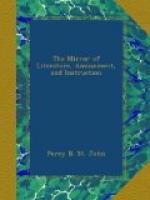That the Jackal is the “Lion’s Provider,” entirely, is an erroneous idea; but it is true that the terrific cry of this animal when in chase, rouses the lion, whose ear is dull, and enables him to join in the pursuit of prey. Many stories are told respecting the generosity of the Lion, and it was once confidently believed that no stress of hunger would induce him to devour a virgin, though his imperial appetite might satiate itself on men and matrons. The title of King of the Beasts, given at a period when strength and ferocity were deemed the prime qualities of man—is now more justly considered to belong to the mild, majestic, and almost rational elephant. The White Elephant is a sacred animal with the Siamese, and the cow with the Bramins and Hindoos.
The Bear was believed never to devour a man whom it found dead; and it was imagined to lick its cubs into proper shape: hence the expression “unlicked cub,” applied to a raw, awkward, unpolished youth. The saliva of the Lama, which when angry it ejects, has been erroneously supposed to possess a corrosive quality.
The hoof of the Moose-deer was formerly in great repute for curing epilepsies, but has now justly fallen into neglect. The Laplander, commencing his journey, whispers into the ear of his Rein-deer, believing these animals understand and will obey his oral directions. The Elk is accounted by the Indians an animal of good omen, and often to dream of him indicates a long life. They imagine also the existence of a gigantic elk, which walks without difficulty in eight feet of snow, has an arm growing from its shoulder which it uses as we do, is invulnerable to all weapons, is king of the elks and attended by a numerous herd of courtiers. The fur of the Glutton is so valued by the Kamschatdales that they say celestial beings are clad in no other.
It was long a popular error that the Porcupine, when irritated, discharged its quills at its adversary; that these quills were poisonous, and rendered wounds inflicted by them difficult to cure: a better acquaintance with the natural history of this harmless animal has now exploded these fables. Our British porcupine, the innocuous Hedgehog, has long been the object of unceasing persecution, from the popular belief that it bites and sucks the udders of cows, an absurdity sufficiently contradicted by the smallness of its mouth. In like manner, the Goat-sucker is a persecuted bird, since, as its name implies, it has been thought to suck the teats of goats and other animals; whereas the form of its bill entirely precludes such an act, and it is an inoffensive bird, living upon insects. The superstition has probably originated from its being often found in warm climates under cattle, capturing the insects that torment them. It is supposed, in some places, that the Shrew-mouse is of so baneful and deleterious a nature that whenever it




